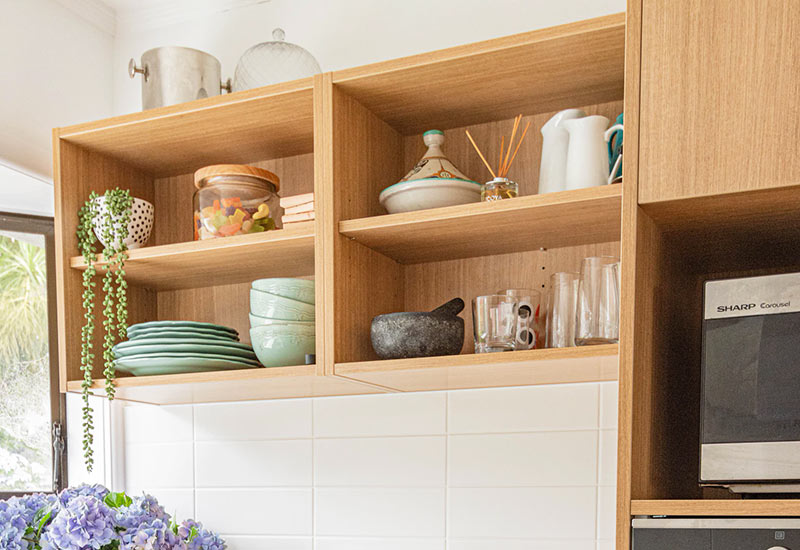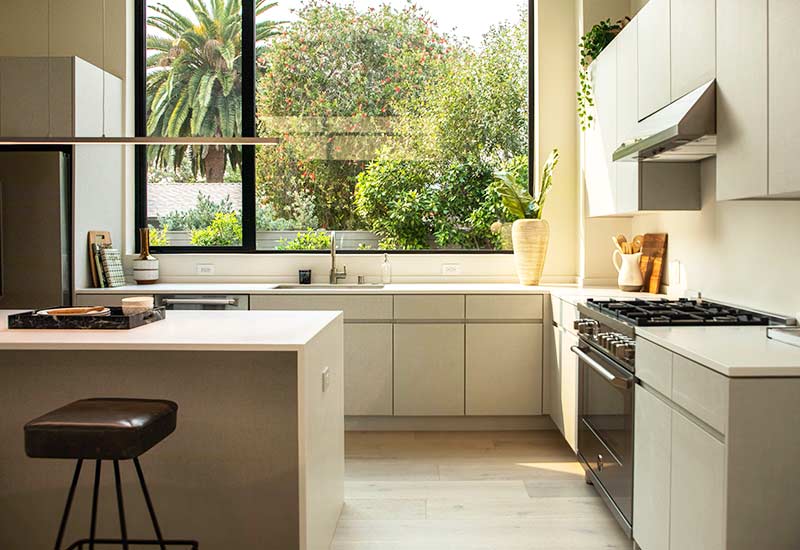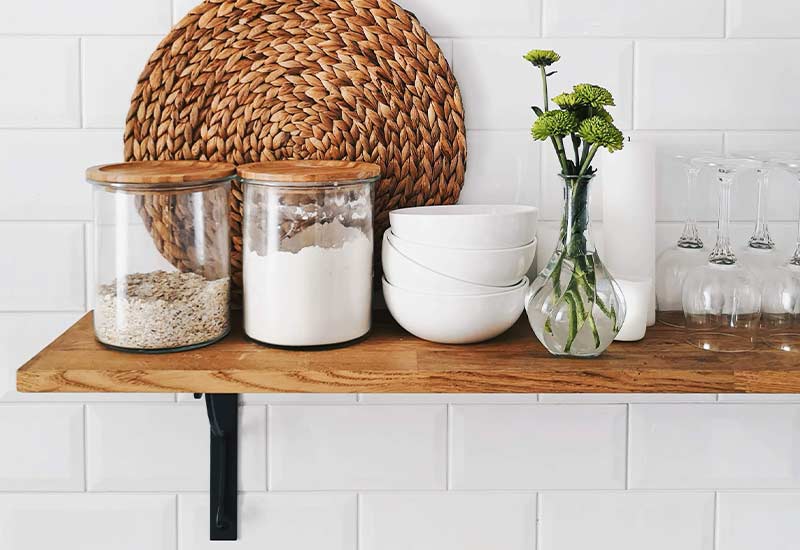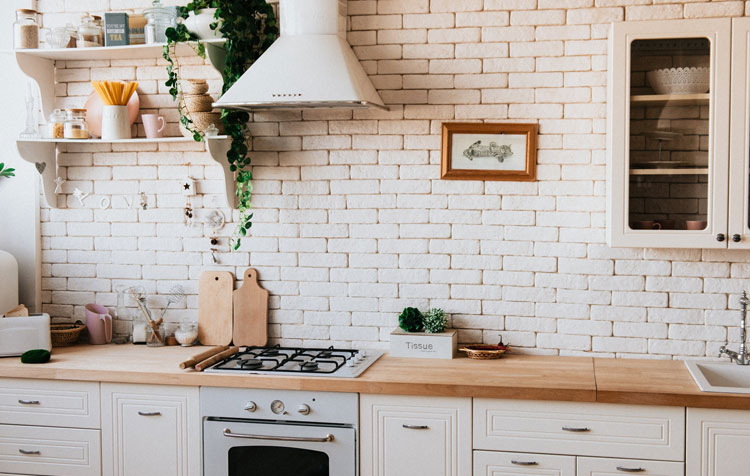Want to know more about sustainable kitchen furniture? Then you've come to the right place! Cooking environmentally friendly is one thing - but making the kitchen itself environmentally friendly is another. For the material of a kitchen to be truly sustainable, it should basically come from environmentally compatible production, be stable and, of course, also be cared for in a way that appreciates its value. But what do consumers really have to look out for in practice when buying a sustainable kitchen?
In this article I would like to give you the most important materials and tips and show you how to get the most ecological kitchen furniture possible - from the cabinets, to the countertop, to the kitchen appliances. Let's go!
Here you can find a small overview in advance:
- Cabinets
- Worktop
- Kitchen appliances
- Decorative layer
- Floor
- Recycling
- Longevity
- Certification
- Brands
- Planning
1. cabinets

Let's start with the kitchen cabinets and their fronts. The regrowing, natural resource Wood is definitely the most used and natural material for this - but not automatically sustainable. Therefore, make sure that they are made from Solid wood manufactured or consists of certified wood-based materials. The material should be Untreated if possible that is, do not contain chemical pollutants. Also, it is recommended that you use wood from ecological forestry you prefer and avoid the use of tropical woods in order to contribute to the Deforestation of the rainforests to stop.
Tip: If you can't find a kitchen that fits your needs, it's also worth talking to your trusted cabinetmaker, who is more likely to use regional resources than a furniture company that operates nationwide.
2. worktop
The same is true for truly sustainable solid and real wood countertops as it is for kitchen cabinets. There are even strong surfaces that are entirely from old furniture, wooden packaging, as well as construction and demolition wood and show no difference in stability compared to conventional models.
Natural stone is also a suitable material. Compared to ceramics, for example, it is produced with significantly lower energy consumption, as it does not have to be composed of different raw materials.
In the meantime, however, there are also ceramics, such as Neolith, which are wonderful as a durable countertop with stone look and feel. The extremely durable material is a recyclable mixture of and natural mineral oxides, clay, feldspar and pebble.
3. kitchen appliances
Whether refrigerator, dishwasher, stove or oven - the appliances in your kitchen should also be environmentally friendly. In addition to the material used, energy efficiency plays a particularly important role in the evaluation. It describes the ratio of utility to energy consumption. The lowest energy consumption is achieved by Devices with an energy efficiency of A (or A+++).
Important: When you save energy in the household your refrigerator should not be exposed to sunlight. Also, should allow you to place the contents in different temperature zones to keep your To make food last longer.
4. decorative layer
The decor is a thin surface layer, which is, for example, over the wooden doors of the kitchen cabinets. It is usually made of high-quality plastic or even paper. A natural-sustainable decor material is also Linoleumwhich consists of natural resins, wood flour, linseed oil and natural color pigments. However, when making your purchase decision, be sure to orient yourself to Paper ecolabelssuch as the Blue Angel.
Tip: If you prefer pure wooden doors without artificial decor, make sure that they are treated with a gentle, natural wood finish.
5. floor

Linoleum, but also certified wood or concrete also count in the kitchen to the sustainable flooring materials. For its sustainability is especially important that the floor is water-repellent, because in the kitchen is more likely to contact liquids and wet food from time to time.
6. recycling
Truly sustainable kitchen furniture should be selected from preferably consist of recycled material, in order to protect the environment. But even after decades of use, ideally, countertops, kitchen tables, kitchen cabinets and electrical appliances should be can be recycled and reprocessed.
Tip: It is not impossible, but quite a bit more difficult to build countertops or cabinets yourself. But even non-professionals can, for example, with a Kitchen table DIY project with recycled oak planks let off steam and create aesthetically pleasing furniture.
7. longevity
If something is truly sustainable, it is not simply environmentally friendly, but also Permanent. Therefore, you should choose kitchen material that is robust, resistant and therefore very durable. However, both when moving in, when installing and not least when using your kitchen, make sure that you keep it and do not damage it if possible. After all, no material in the world is sustainable if it is not cared for or handled too roughly.
8. certification
When buying a kitchen, it's difficult to do everything perfectly. But there are some environmental labels that give you a useful orientation in the kitchen studio to act more sustainably. Here I would like to briefly list the most important labels by which you can recognize a fair and ecologically produced:
- EcoControl (pollutant test seal)
- PEFC and FSC seal (ecological forestry)
- DGM climate label (climate protection)
- Blue Angel (generally environmentally friendly products and services)
- ISO 50001 certification (energy)
- Made in Germany (Quality Assurance)
- GS mark (Safety and reliability)
- RKT Recycling Certificate (closed loops for packaging)
- …
Can you think of any other important seals? Then just write me a comment with your suggestion. I will be happy to add it to this list.
9. brands
Probably there is never absolute certainty - but there are definitely some brands by which you can recognize very sustainable kitchen furniture. Again, I have compiled a small list of examples for you:
- OSTER Kitchens: The company from the Moselle town of Cochem manufactures solid wood kitchens and plants trees for every kitchen delivered. In addition, the responsible parties do without tropical wood and use only wood from ecological forestry. The finishing also takes place with harmless substances.
- Walden Kitchens: The Austrian company "walden" also relies on European woods, such as beech heartwood, robinia and oak. The kitchens have been awarded the Austrian Ecolabel.
- SCHMIDT Kitchens: The German-French kitchen manufacturer creates kitchens that are made of 100 percent recycled wood. The company's products have been awarded the PEFC seal and the "Green Franchise Award" business prize, among others.
- Redpoint Kitchens: The company from Bünde in North Rhine-Westphalia pursues a clear sustainability strategy and is particularly committed to reducing its own CO2 emissions. The company's kitchens are made of up to 90 percent recycled wood and have been awarded environmental seals such as "FSC", the "Blue Angel" and also "CradleToCradle".
- …
Can you think of any other eco-friendly kitchen manufacturers? Then I'm eager to hear your reasoned comment!
10. planning

Whether a fitted kitchen, modular kitchen, country kitchen, kitchenette, eat-in kitchen, designer kitchen or pantry kitchen - even the most environmentally friendly kitchen is not very sustainable if it has not been planned for the long term. Where do I put the cutlery, how do I cook, how much space do I need between the kitchen unit and kitchen island and how high does my worktop need to be? Questions upon questions that you should definitely answer clearly. I recommend a kitchen planner to help you avoid any planning mistakes and stay happy and satisfied with your kitchen for as long as possible.
Find sustainable kitchen furniture? No problem at all!
Nobody has to do everything perfectly - neither the manufacturer, nor the consumer. But everyone can make a real contribution to more sustainability in the kitchen industry. The manufacturer with recyclable, recycled, natural and durable materials, the consumer through a conscious, considered choice and an appreciation for natural resources.
I hope that I was able to help you with this article on sustainable kitchen furniture and that you are now well equipped to make sensible and eco-friendly choices at the kitchen store.
Stay sustainable,

PS.: Through a Plastic-free kitchen if possible you can avoid waste in a targeted manner and make a further contribution for a more sustainable lifestyle of our society. In the linked articles you can now find out what you can do.






